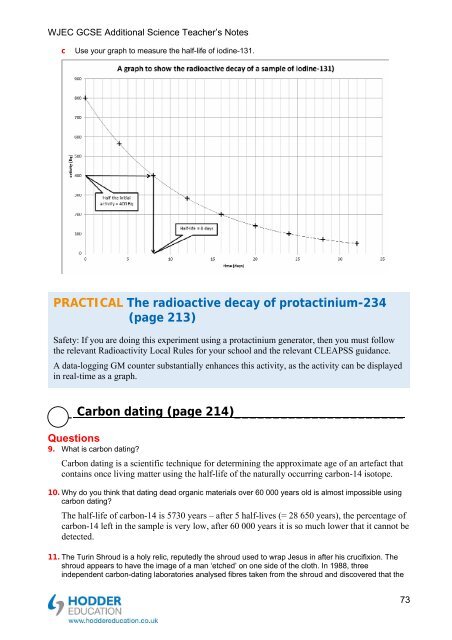Teacher's notes and answers to questions in the book - Hodder Plus ...
Teacher's notes and answers to questions in the book - Hodder Plus ...
Teacher's notes and answers to questions in the book - Hodder Plus ...
You also want an ePaper? Increase the reach of your titles
YUMPU automatically turns print PDFs into web optimized ePapers that Google loves.
WJEC GCSE Additional Science Teacher’s Notes<br />
c<br />
Use your graph <strong>to</strong> measure <strong>the</strong> half-life of iod<strong>in</strong>e-131.<br />
PRACTICAL The radioactive decay of protact<strong>in</strong>ium-234<br />
(page 213)<br />
Safety: If you are do<strong>in</strong>g this experiment us<strong>in</strong>g a protact<strong>in</strong>ium genera<strong>to</strong>r, <strong>the</strong>n you must follow<br />
<strong>the</strong> relevant Radioactivity Local Rules for your school <strong>and</strong> <strong>the</strong> relevant CLEAPSS guidance.<br />
A data-logg<strong>in</strong>g GM counter substantially enhances this activity, as <strong>the</strong> activity can be displayed<br />
<strong>in</strong> real-time as a graph.<br />
_ Carbon dat<strong>in</strong>g (page 214)______________________<br />
Questions<br />
9. What is carbon dat<strong>in</strong>g<br />
Carbon dat<strong>in</strong>g is a scientific technique for determ<strong>in</strong><strong>in</strong>g <strong>the</strong> approximate age of an artefact that<br />
conta<strong>in</strong>s once liv<strong>in</strong>g matter us<strong>in</strong>g <strong>the</strong> half-life of <strong>the</strong> naturally occurr<strong>in</strong>g carbon-14 iso<strong>to</strong>pe.<br />
10. Why do you th<strong>in</strong>k that dat<strong>in</strong>g dead organic materials over 60 000 years old is almost impossible us<strong>in</strong>g<br />
carbon dat<strong>in</strong>g<br />
The half-life of carbon-14 is 5730 years – after 5 half-lives (= 28 650 years), <strong>the</strong> percentage of<br />
carbon-14 left <strong>in</strong> <strong>the</strong> sample is very low, after 60 000 years it is so much lower that it cannot be<br />
detected.<br />
11. The Tur<strong>in</strong> Shroud is a holy relic, reputedly <strong>the</strong> shroud used <strong>to</strong> wrap Jesus <strong>in</strong> after his crucifixion. The<br />
shroud appears <strong>to</strong> have <strong>the</strong> image of a man ‘etched’ on one side of <strong>the</strong> cloth. In 1988, three<br />
<strong>in</strong>dependent carbon-dat<strong>in</strong>g labora<strong>to</strong>ries analysed fibres taken from <strong>the</strong> shroud <strong>and</strong> discovered that <strong>the</strong><br />
73

















